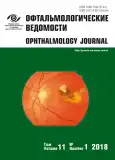Zonular instability in patients with pseudoexfoliative syndrome: the analysis of 1000 consecutive phacoemulsifications
- 作者: Potyomkin V.V.1, Ageeva E.V.2
-
隶属关系:
- Academician I.P. Pavlov First Saint Petersburg State Medical University
- City hospital No 2
- 期: 卷 11, 编号 1 (2018)
- 页面: 41-46
- 栏目: Articles
- URL: https://journals.rcsi.science/ov/article/view/8648
- DOI: https://doi.org/10.17816/OV11141-46
- ID: 8648
如何引用文章
详细
Phacoemulsification (PHACO) is the gold standard of cataract surgery. Сataract surgery in eyes with pseudoexfoliative (PEX) syndrome is associated with increased risk of intra- and postoperative complications. Zonular laxity is one of the main causes of surgical complications.
Purpose. To assess the degree of zonular weakness in patients with PEX.
Materials and methods. 1010 eyes (580 eyes with PEX and 430 eyes without it) that underwent consecutive PHACO at the Ophthalmology Department No 5 of the City Multifunctional Hospital No 2 from May 2016 until October 2017 were enrolled in the study. The zonular laxity was assessed preoperatively and intraoperatively.
Results. Zonular weakness was observed more often in patients with PEX, both at preoperative and intraoperative evaluation (p < 0.05). However, in both groups, the percentage of zonular weakness estimated intraoperatively, was several times higher, than that estimated preoperatively. Nevertheless there was no difference in the rate of capsular bag related intraoperative complications between two groups.
作者简介
Vitaly Potyomkin
Academician I.P. Pavlov First Saint Petersburg State Medical University
编辑信件的主要联系方式.
Email: potem@inbox.ru
PhD, assistant professor. Department of Ophthalmology
俄罗斯联邦, Saint PetersburgElena Ageeva
City hospital No 2
Email: ageeva_elena@inbox.ru
Ophthalmologist
俄罗斯联邦, Saint Petersburg参考
- Arshinoff SA. Dispersive-cohesive viscoelastic soft shell technique. J Cataract Refract Surg. 1999;25(2):167-173. doi: 10.1016/s0886-3350(99)80121-7.
- Bencic G, Zoric-Geber M, Saric D, et al. Clinical importance of the lens opacities classification system III (LOCS III) in phacoemulsification. Coll Antropol. 2005;29 Suppl 1:91-94.
- Bourne RRA, Stevens GA, White RA, et al. Causes of vision loss worldwide, 1990-2010: a systematic analysis. Lancet. 2013;1(6): e339-e349. doi: 10.1016/s2214-109x(13)70113-x.
- Bayraktar Ş, Altan T, Küçüksümer Y, Yılmaz ÖF. Capsular tension ring implantation after capsulorhexis in phacoemulsification of cataracts associated with pseudoexfoliation syndrome. J Cataract Refract Surg. 2001;27(10):1620-1628. doi: 10.1016/s0886-3350(01)00965-8.
- Busic M, Kastelan S. Pseudoexfoliation syndrome and cataract surgery by phacoemulsification. Coll Antropol. 2005;29 Suppl 1:163-166.
- Conway RM, Schlotzer-Schrehardt U, Kuchle M, Naumann GO. Pseudoexfoliation syndrome: pathological manifestations of relevance to intraocular surgery. Clin Exp Ophthalmol. 2004;32(2):199-210. doi: 10.1111/j.1442-9071.2004.00806.x.
- Ekstrom C, Botling Taube A. Pseudoexfoliation and cataract surgery: a population-based 30-year follow-up study. Acta Ophthalmol. 2015;93(8):774-777. doi: 10.1111/aos.12789.
- Freissler K. Spontaneous Dislocation of the Lens in Pseudoexfoliation Syndrome. Arch Ophthalmol. 1995;113(9):1095. doi: 10.1001/archopht.1995.01100090017008.
- Hashemi H, Seyedian MA, Mohammadpour M. Small pupil and cataract surgery. Curr Opin Ophthalmol. 2015;26(1):3-9. doi: 10.1097/ICU.0000000000000116.
- Jacob S, Agarwal A, Agarwal A, et al. Efficacy of a capsular tension ring for phacoemulsification in eyes with zonular dialysis. J Cataract Refract Surg. 2003;29(2):315-321. doi: 10.1016/s0886-3350(02)01534-1.
- Jehan FS, Mamalis N, Crandall AS. Spontaneous late dislocation of intraocular lens within the capsular bag in pseudoexfoliation patients. Ophthalmology. 2001;108(10):1727-1731. doi: 10.1016/s0161-6420(01)00710-2.
- Kanthan GL, Mitchell P, Burlutsky G, et al. Pseudoexfoliation syndrome and the long-term incidence of cataract and cataract surgery: the blue mountains eye study. Am J Ophthalmol. 2013;155(1):83-88 e81. doi: 10.1016/j.ajo.2012.07.002.
- Carifi G. Pseudoexfoliation syndrome and cataract surgery. Eur J Ophthalmol. 2012;22(5):864-865; author reply 865-867. doi: 10.5301/ejo.5000104.
- Küchle M, Viestenz A, Martus P, et al. Anterior chamber depth and complications during cataract surgery in eyes with pseudoexfoliation syndrome. Am J Ophthalmol. 2000;129(3):281-285. doi: 10.1016/s0002-9394(99)00365-7.
- Malyugin B. Small Pupil Phaco Surgery: A New Technique. Ann Ophthalmol. 2007;39(3):185-193. doi: 10.1007/s12009-007-0023-8.
- Naumann GO, Kuchle M, Schonherr U. Pseudo-exfoliation syndrome as a risk factor for vitreous loss in extra-capsular cataract extraction. The Erlangen Eye Information Group. Fortschr Ophthalmol. 1989;86(6):543-545.
- Schlotzer-Schrehardt U. Pseudoexfoliation syndrome: the puzzle continues. J Ophthalmic Vis Res. 2012;7(3):187-189.
- Schlötzer-Schrehardt UM. Pseudoexfoliation Syndrome Ocular Manifestation of a Systemic Disorder? Arch Ophthalmol. 1992;110(12):1752. doi: 10.1001/archopht.1992.01080240092038.
- Schlötzer-Schrehardt U, Naumann GOH. A Histopathologic Study of Zonular Instability in Pseudoexfoliation Syndrome. Am J Ophthalmol. 1994;118(6):730-743. doi: 10.1016/s0002-9394(14)72552-8.
- Shingleton BJ, Crandall AS, Ahmed, II. Pseudoexfoliation and the cataract surgeon: preoperative, intraoperative, and postoperative issues related to intraocular pressure, cataract, and intraocular lenses. J Cataract Refract Surg. 2009;35(6):1101-1120. doi: 10.1016/j.jcrs.2009.03.011.
- Vazquez-Ferreiro P, Carrera-Hueso FJ, Poquet Jornet JE, et al. Intraoperative complications of phacoemulsification in pseudoexfoliation: Metaanalysis. J Cataract Refract Surg. 2016;42(11):1666-1675. doi: 10.1016/j.jcrs.2016.09.010.
补充文件







